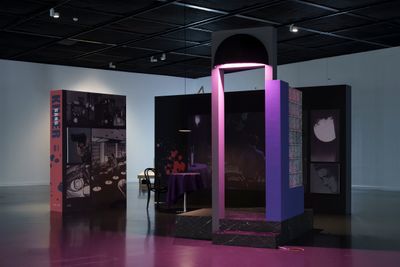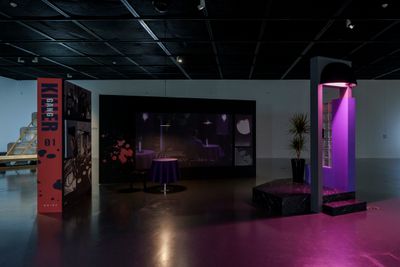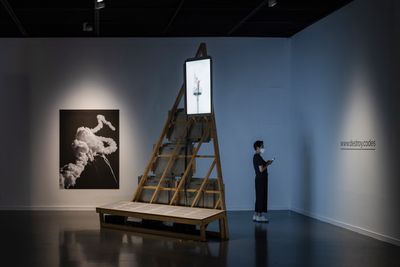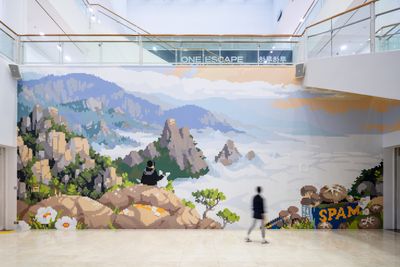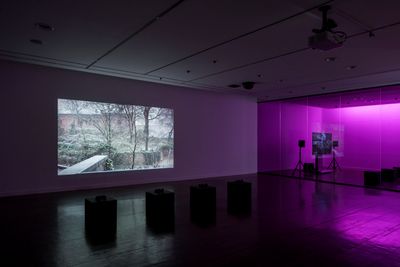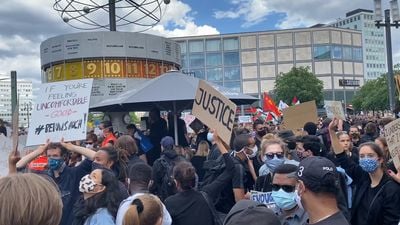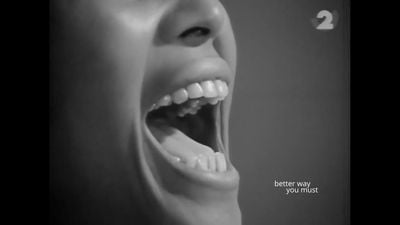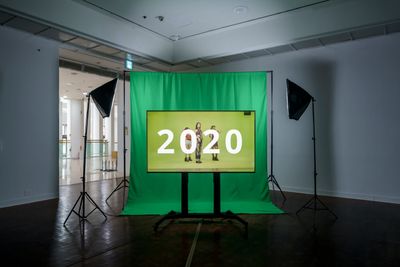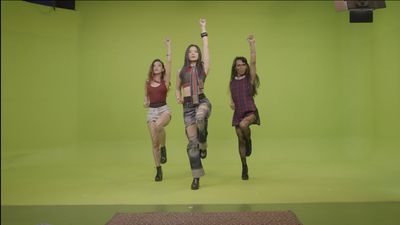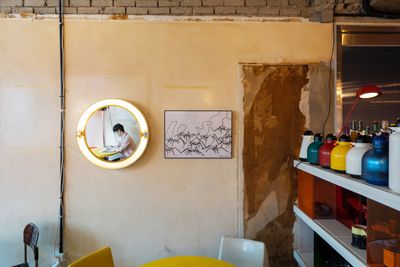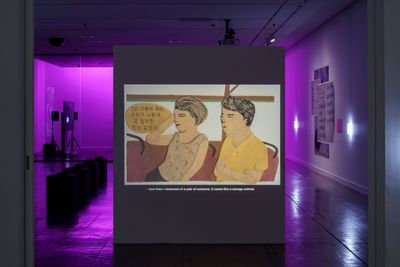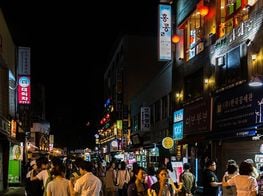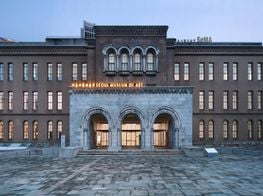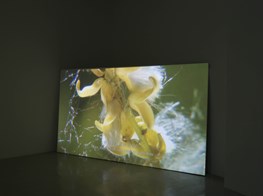Seoul Mediacity Biennale Escapes to Connect
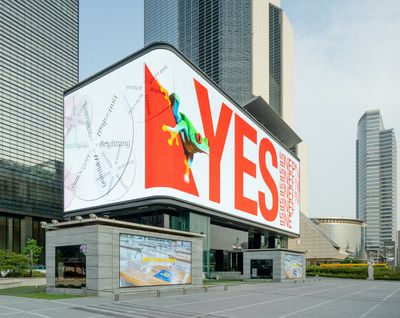
TASTEHOUSE × WORKS, OoH (2021). Exhibition view: One Escape at a Time, 11th Seoul Mediacity Biennale, K-Pop Square, Seoul (8 September 2021–21 November 2021). Courtesy Seoul Mediacity Biennale. Photo: Cheolki Hong, glimworkers.
Timeless yet current, boundless yet grounded, and connected yet isolated, the 11th Seoul Mediacity Biennale, One Escape at a Time (8 September 2021–21 November 2021), utilises escapism to find connections in a world upended.
Directed by Yung Ma, 58 artworks by 41 artists have been organised under a show title inspired by the sharp-witted Netflix sitcom One Day at a Time (2017–2020), based on an original 1970s production, that revolves around a Cuban American family living in Los Angeles and tackles urgent socio-political issues such as racism, gender, class, sexuality, identity, and migration.
The main exhibition, staged over the entire three floors of the Seoul Museum of Art, creates room for nostalgia and reimagination, with the majority of works utilising popular culture—from sitcoms, film, comics, literature, to advertisements—to encourage critical contemplations on life today.
On the first and second floors, some works draw from the 1980s and 90s in Hong Kong and Mainland China. Sarah Lai's installation Gang Killer (2021), located on the first floor, is staged like a piano bar, with three separate walls set apart from each other to create a scene.
One wall hosts a bar entrance with neon light on one side, and translucent glass invoking the interior of a bar on the other. Two other walls, one covered with the image of a lone character in a bar with bloodstains, complete the enclosure; emblazoning their outer edges is the phrase 'KILLER GANG 01' and the image of a shotgun pointed at the viewer.
An empty table and hanging light installed together complete the scene, creating a visceral and heightened mood that recalls John Woo's classic Hong Kong film The Killer (1989), a stylish action thriller made the year of the Tiananmen Square crackdown that taps into the turbulence of the times.
Nostalgia shifts to romance in Liu Chuang's Love Story (2013/2021), a series of digital inkjet prints depicting 17 pages from romance novels popular in Mainland China during the 1980s and 90s, mostly written by authors in Taiwan and Hong Kong.
Chuang bought the publications from a book rental store in Dongguan, an industrial city inhabited by many young female workers, and recomposed the anonymous hand-written notes made by the readers found on book pages into each print.
One print illustrates a book cover of lovers together with personal comments on pages, including 'This is not a job, but rotten, 2010' and 'Foreign factory, China factory, Foreign factory, China factory ... Back home.'
Throughout, nostalgia becomes a theme that resonates beyond a longing for the past...
Such notes resonate in the context of South Korea, where light industrial cities such as Ansan have become the centre of political debates surrounding migrant labour, with migrant workers from Mainland China and Southeast Asia subjected to harsh restrictions during the pandemic without the provision of better working or living conditions.
Prints from Chuang's Love Story appear across two floors of the museum, reflecting a curatorial approach that offers multiple routes through themes and narratives that orbit and reverberate through the exhibition.
Throughout, nostalgia becomes a theme that resonates beyond a longing for the past, inviting a reconnection with histories of lived experience to consider urgent issues in the present.
Located on the second floor, for instance, Hao Jingban's 21-minute single-channel video work, I Understand... (2021) is an autobiographical essay about the artist's experience living in Berlin at the time of the pandemic and the Black Lives Matter (BLM) movement.
The filmed and sourced footage of protests is accompanied by the artist's narration that reflects on the complexity of her experiences, which inevitably reminds her (and us) of what has happened in Hong Kong in recent years.
The video starts with the words 'dear my friend' narrated atop a blank screen. As the artist's narration is delivered, footage of BLM protests in Berlin, which the artist filmed herself, is juxtaposed with other video and sound sources.
These include a performance of 'Tears for Johannesburg' by Max Roach and Abbey Lincoln in the 1960s, an interview with Nina Simone talking about artists' social responsibility, and the audio of Bob Dylan's song 'Murder Most Foul' (2020).
In this subtle and layered video essay, Hao Jingban seems to ask viewers to think about disparities between solidarity movements in China and ecent social and political injustice movements in other parts of the world.
Popular music appears in other works in the show, from jazz to K-pop, so as to play on the strong associations that can be drawn from tracks, titles, and lyrics.
Eisa Jocson's music video and installation Superwoman: Empire of Care (2021), located on the second floor, adopts K-pop's costumes and choreography to criticise the living conditions of Filipino migrants and medical and essential workers during the pandemic in the Philippines. Movements in the video constantly cut off abruptly, and the lyrics of Karyn White's 1989 pop song 'Superwoman' are reworked with a mash-up of Blackpink's 2019 single 'Kill This Love'.
Against a green screen background, in which the costumes are constantly changing from K-pop style to medical workers' protective clothing, Jocson and two band members Bunny Cadag and Cathrine Go sing lyrics like: 'Modern-day heroes, superheroes are what you call us. But when we cry for help you pretend that you don't hear us...'
In Yung Ma's exhibition, forms of escape lead to points of contact and connection.
The crossover between issues relating to Filipino medical workers, who are heralded as national heroes in the Philippines yet denied basic securities, and the commercialised, instrumentalised genre of K-pop creates a relational critique in Jocson's work.
When the South Korean government promotes K-pop internationally, it does not merely use 'Korean' as a modifier, but utilises it as a form of national pride and international recognition.
But with recent and ongoing labour strikes among unionised delivery workers and the Korean Health and Medical Workers' Unions, it is clear that workers do not need national pride as much as they need safe and secure working environments.
Jocson's work will expand when Superwoman: Empire of Care will be aired on public broadcaster TBS (TV) in September and screened on K-Pop Square Media at the COEX (Convention and Exhibition Center) Atrium media façade in October as part of Network, a citywide project bringing artworks to some 100 locations across Seoul within the public programme Echoes.
In the context of this biennial, Network seems to act as a reminder not only to stay connected but to find connections in overwhelming times, when information overload is matched by a steady stream of political and environmental crises.
One example of the disseminated forms that Network takes is the biennial's monthly magazine Routes—consisting of short interviews with artists, directors, one restaurant owner, and one bookshop owner—distributed in cafés, restaurants, and bookshops.
In the magazine, we learn that Chihoi's Carousel (2014)—comprising excerpted drawings from three Hong Kong comic books, Comic Hong Kong Literature (2007), The Train (2007), and The Library (2013), and ten faded photographs capturing Hong Kong in the past—is presented as a slide projection in the exhibition. One such drawing is on display as a framed print at the bookshop PRNT.
In this frame, the term 'escapism', which often implies a myopic distraction or a mystical illusion away from everyday life in a socioeconomically and politically charged reality, is redefined. In Yung Ma's exhibition, forms of escape lead to points of contact and connection. —[O]


